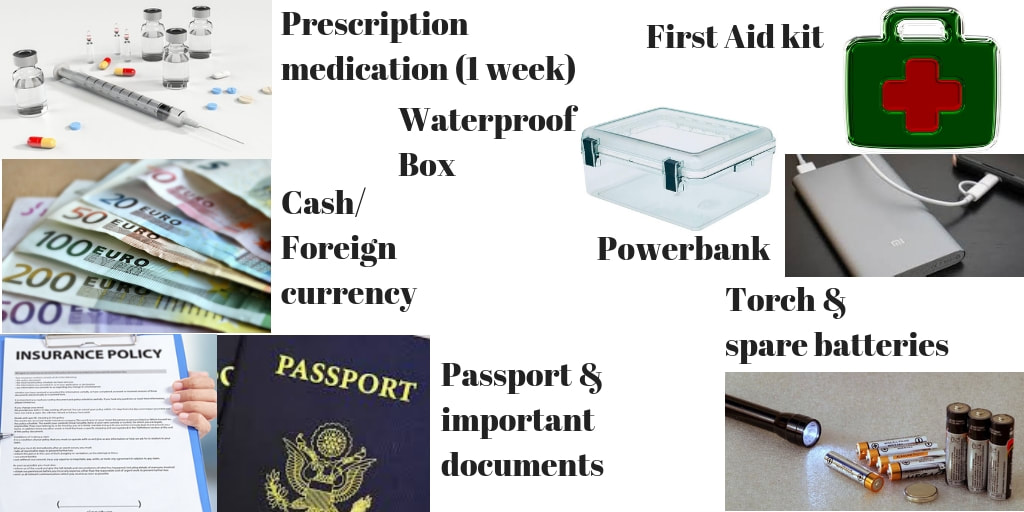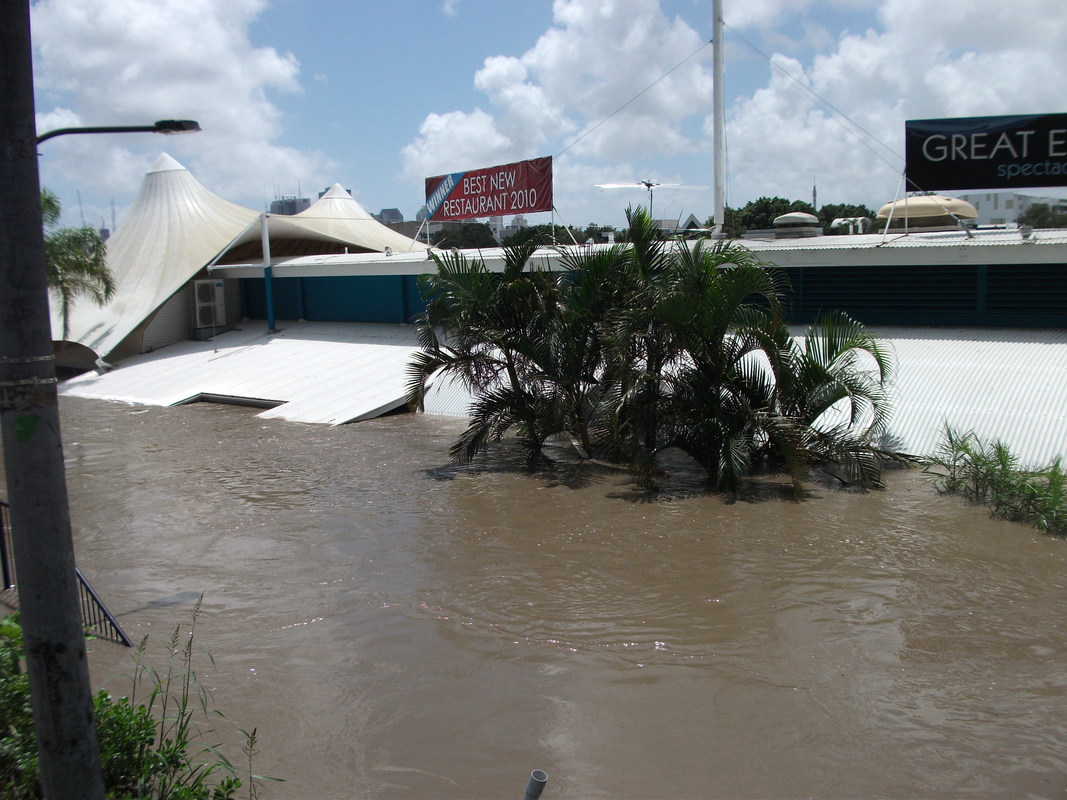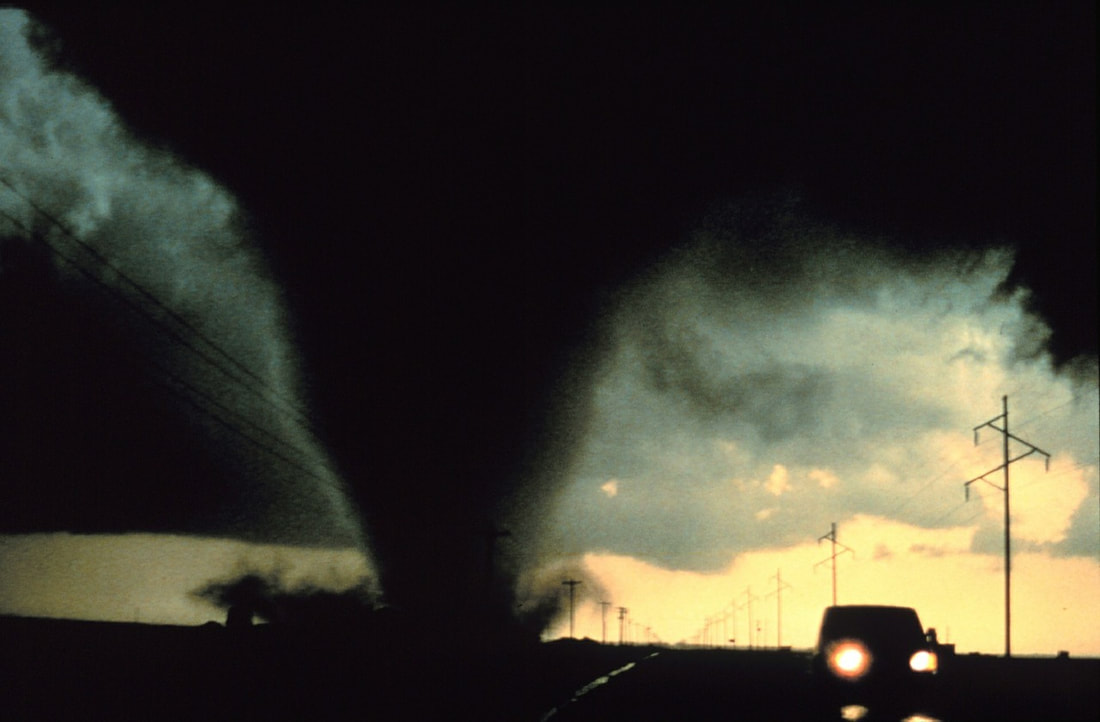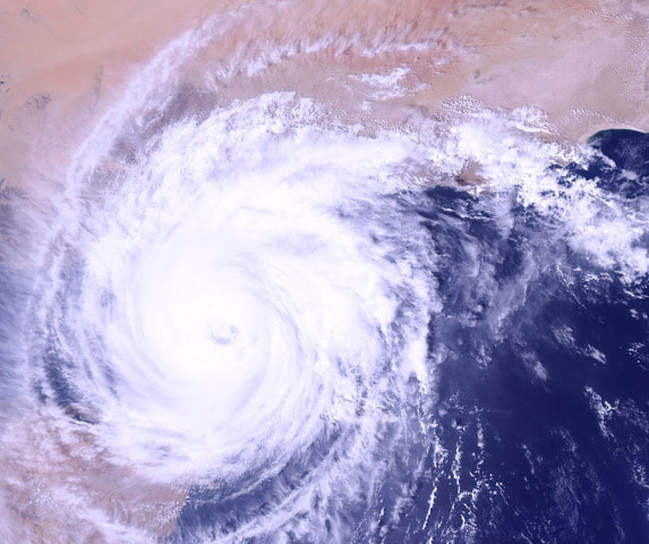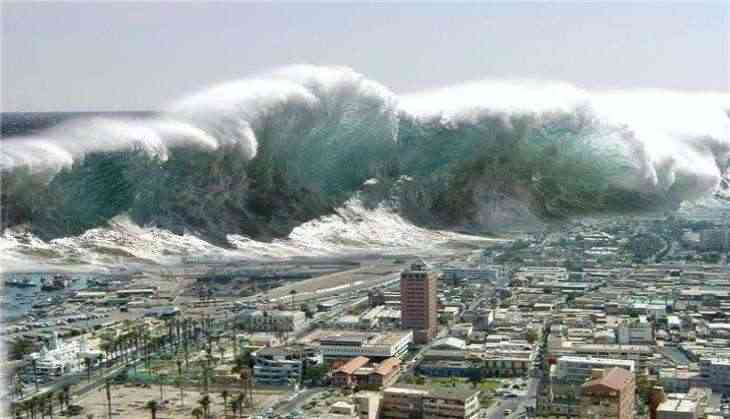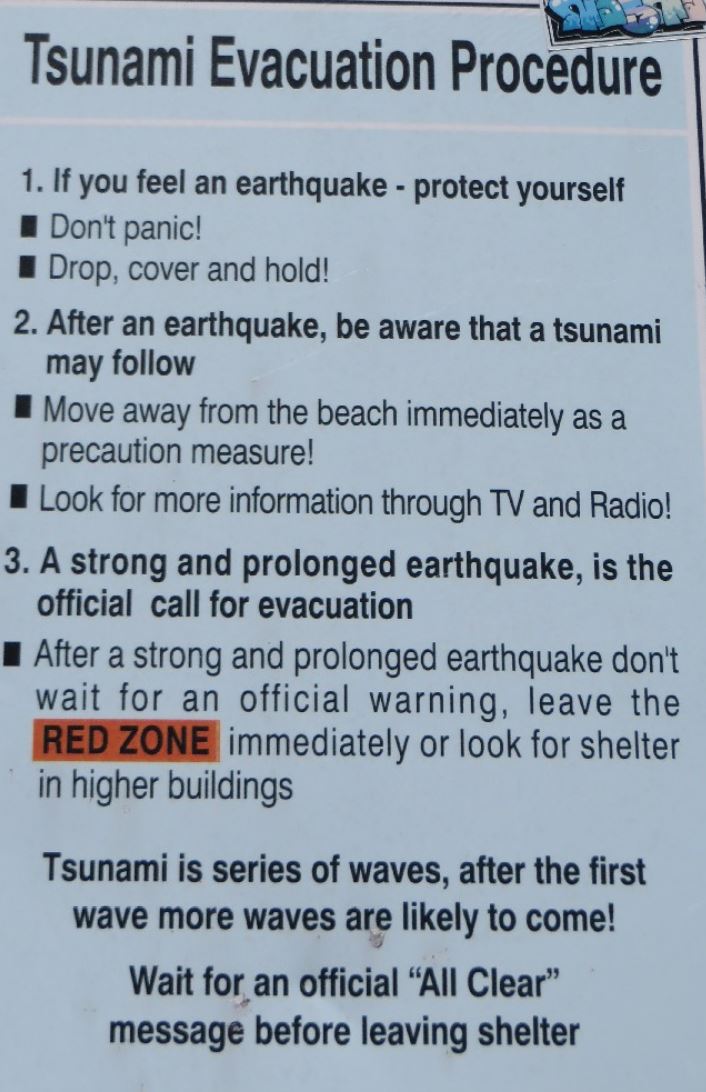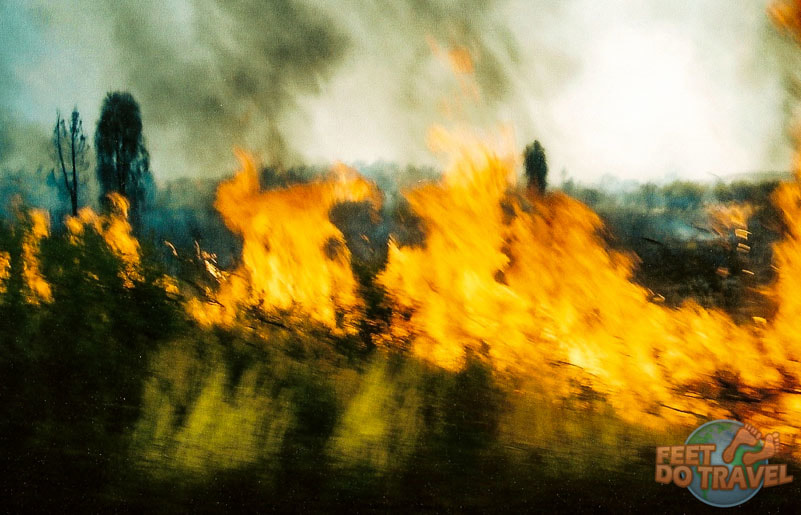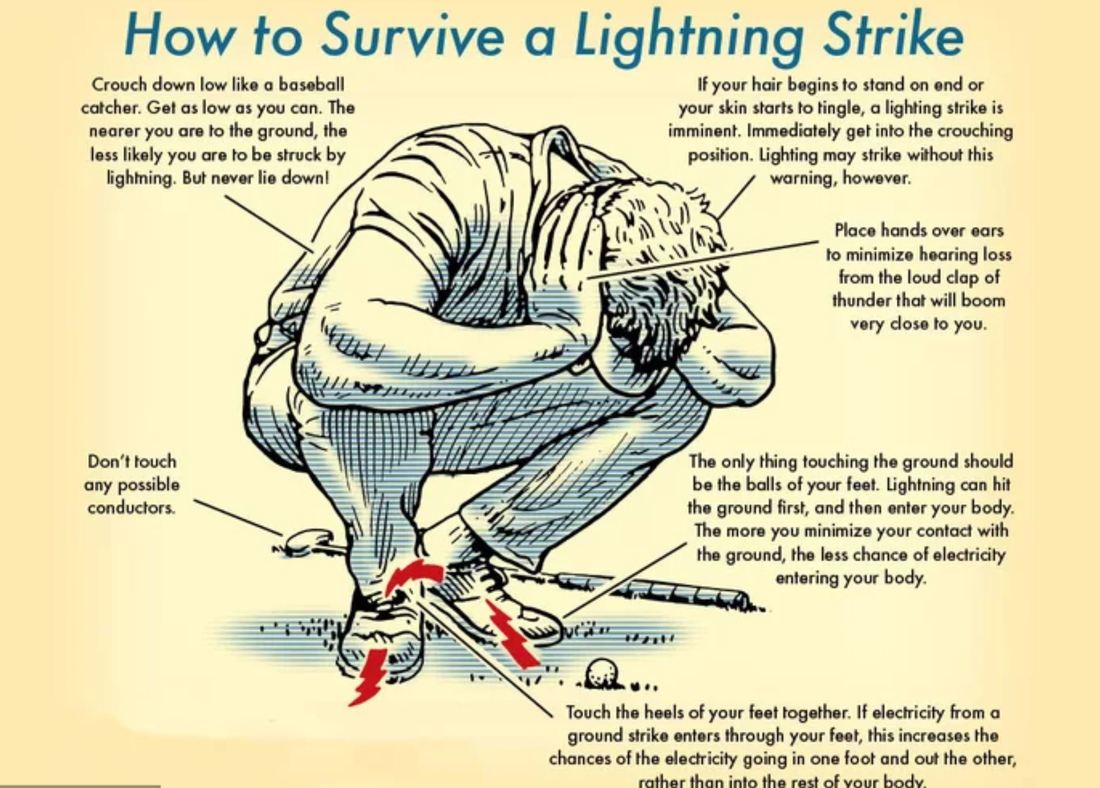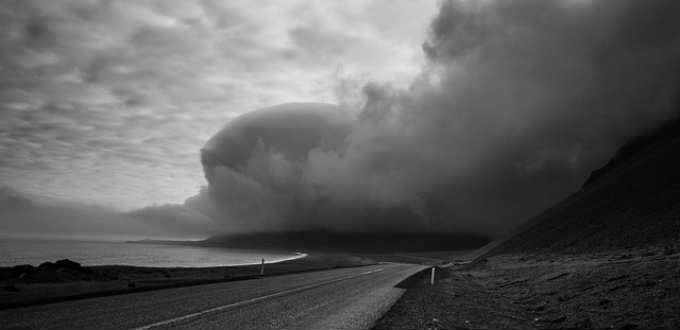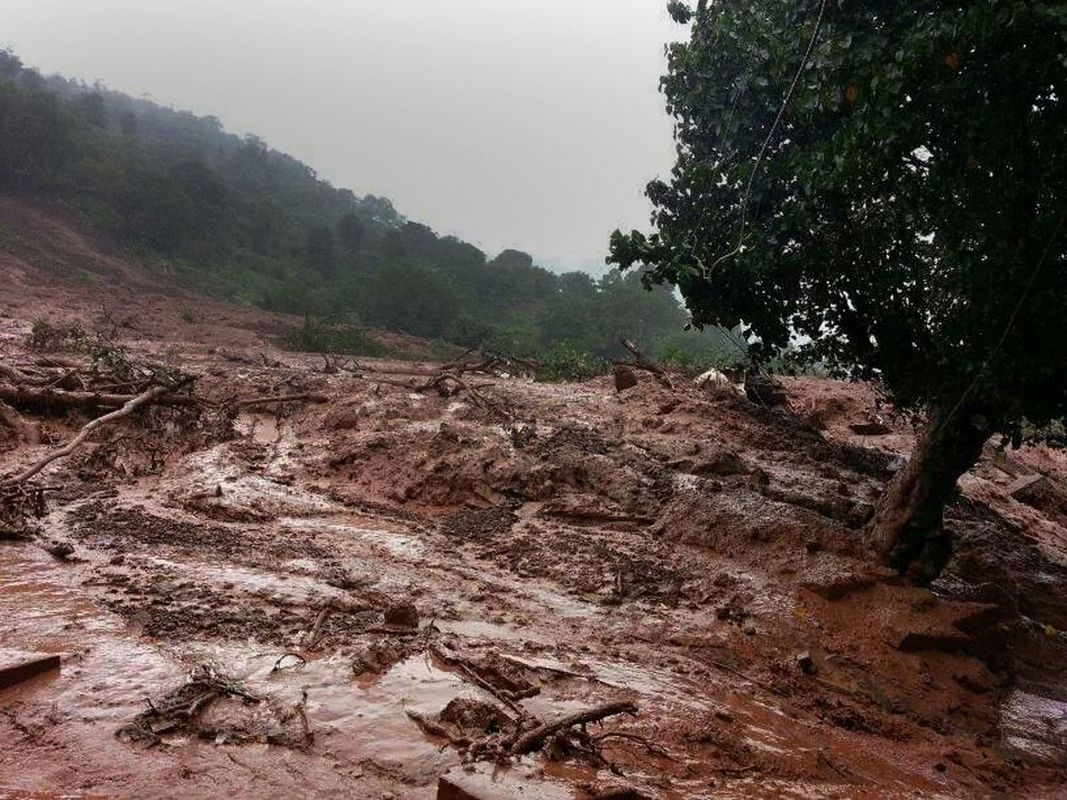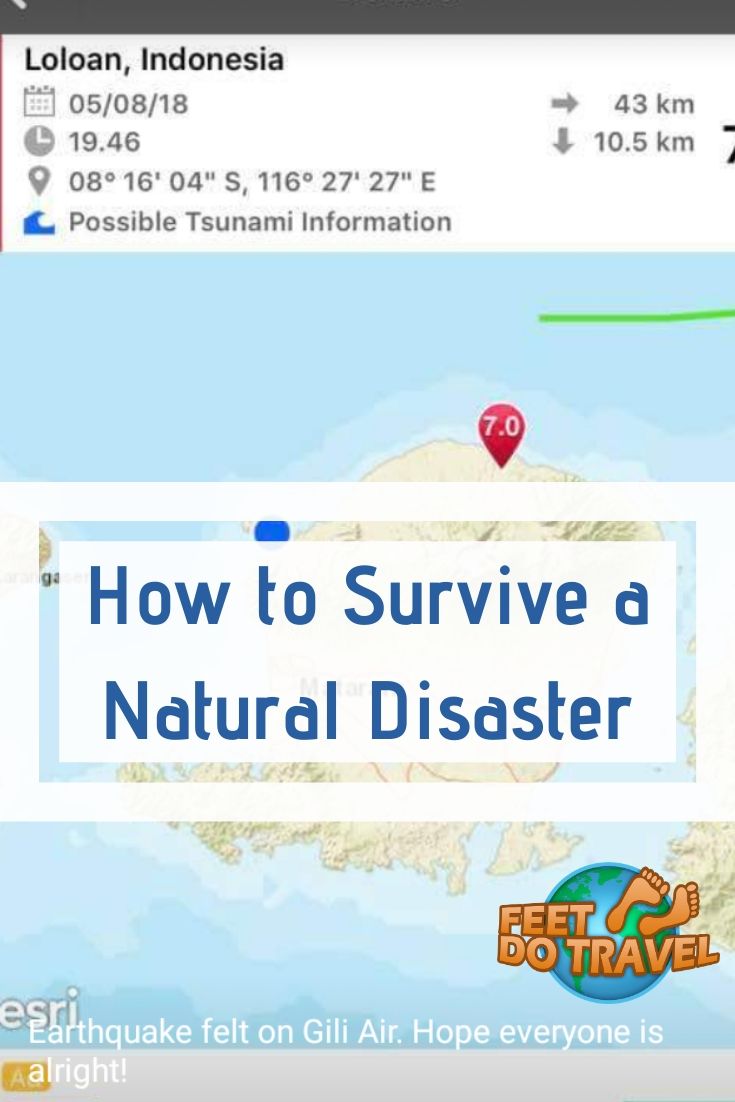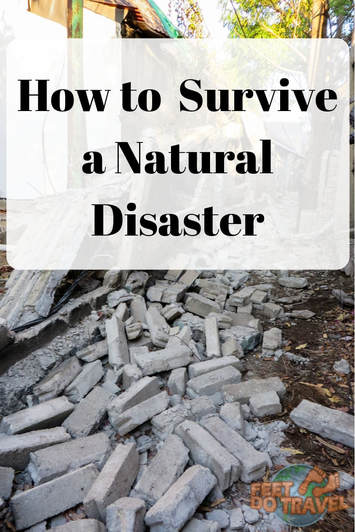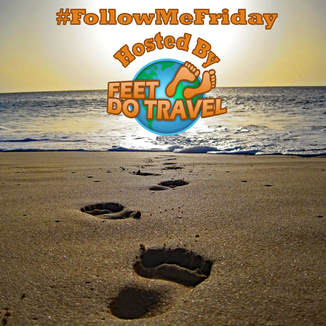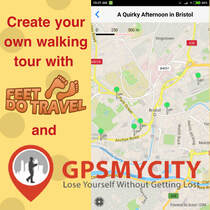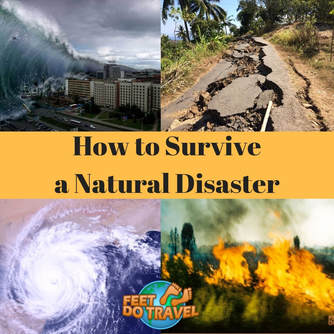
It’s devastating for residents living within a country, but as travellers, any one of us could be visiting somewhere when a natural disaster occurs.
When we were in the Lombok earthquake on 5 August, we had no idea what to do, we just tried to think rationally and survival mode kicked in. When a tsunami warning was in place, for this we knew what to do – get to high ground.
This post isn’t intended to scare, but to educate us all on what to do when faced with circumstances we are unfamiliar with. I haven’t endured all the situations within this post, if I had, I’m unsure if I would be the luckiest person still alive, or the unluckiest to have been in these disasters in the first place! So I spoke with my travel blogger friends to create this post.
I hope we are all able to learn how to survive a natural disaster.
No one wants to be involved in a natural disaster, but with a bit of knowledge, you will hopefully know what to do should you become caught up in one of these events on your travels. This post isn’t a comprehensive guide, but there is just enough information to educate you more regarding disaster situations, with website links for additional reading.
I asked my travel blogger friends to briefly talk about their experience of being in a natural disaster, sometimes people did things right, other times we can learn from their mistakes. And that is the reason I chose to write this post; because the majority of us will make mistakes … I know we did in the earthquake.
The official advice for all natural disasters is to have an emergency kit which should contain:
- Important documents including passport, insurance papers kept in a waterproof container
- Cash in local currency – if the electricity power is cut, you cannot withdraw from an ATM
- A week’s worth of prescription medication
- First Aid kit
- Torch with spare batteries
- Candles with a lighter/matches
- Powerbank – you may be out of electricity for a while
- A battery powered radio and spare batteries so you can listen to advisory warnings
- A change of clothes that are ideally waterproof and warm
- Stockpile bottles of water, at least six litres per person (enough for two litres per person for three days)
- Non-perishable food, enough for a few days at the very least (more in certain circumstances)
This is obviously a best-case scenario, but even if you can just have a waterproof bag/box with the most important pieces, this is better than nothing.
Download a weather app like Weather Bug, YR or Accuweather. Although they are not necessarily 100% reliable, they may give you a good indication and time to prepare. Pay attention to weather patterns in your area and always have a plan if the weather starts to turn bad. If you know extreme conditions are heading your way, you can gather more items for your emergency kit listed above.
An emergency evacuation plan should be formed with your family. Pick a safe meeting place in case you need to leave home eg a friends’ house in a safe area. Make sure everyone knows how to get there. Know where your Embassy is.
You should also keep loved ones informed as soon as you are aware of any disaster. Send a text, it’s more likely to be sent and won’t block up the phone line.
(Statistics show floods, especially flash floods, kill more people than any other disaster)
By Kirstin of The Tin Berry Travels
In 2011, the Queensland, Australia floods made headlines around the world as one of Australia’s biggest natural disasters. Living in Brisbane at the time, we began to watch television footage of the frightening developments across the region as floodwater from elsewhere in the state moved toward Brisbane. We watched as suburb after suburb of our city was asked to evacuate in rising water but, having made the decision to wait until everyone from our flatshare was together, we missed our window to leave so had to stay put.
Roads were cut off and power lost on the first day. Over several more days, we watched as neighbours homes succumbed to the waters. Highways were swept away and listening via emergency radio, we heard the death toll continue to rise.
After a week the waters had almost gone, but damage to the city was billions of dollars and visible everywhere. We were lucky to be on high ground, others lost everything.
Tips on surviving floods
- If you know a flood is coming, prepare early. Know where official disaster information comes from, evacuate if possible and prepare to be cut off.
- Listen to authorities – if they tell you to leave then leave and always head for high ground. Only take your emergency kit, leave everything else.
- If you have to evacuate, get to high ground away from water – stay away from rivers, lakes etc and do not cross any water. Remember the motto “Turn around, don't drown” If you have no choice but cross water, take a stick with you – use it to measure the depth of water and feel for stable ground.
- If you are at home, head for the roof.
- Never enter floodwaters and remember that once water recedes, danger still exists in the sludge left behind and unsafe structures so continue to monitor official advice well after the event.
- For more tips - How to survive a flood
By Lolo of Caliglobetrotter
It was 1997 and 11-year old Lolo was quite distraught. Her best friend had moved to Arkansas. Distraught with grief, her loving Mama saw only one way to resolve this tinsy itty bitty problem – a road trip! So, mother, daughter and, Scooby, a miniature Sheltie, departed from sunny SoCal to Bentonville, Arkansas.
All checked in to the hotel, things quickly changed and 11-year old Lolo thought the world would come crashing to an end. No matter how many times she clicked her heels and said, “There’s no place like home”, that tornado warning blaring across the TV just wouldn’t disappear. Scared out of her glittery red shoes, the hotel staff informed these Cali girls that the safest place was… the bathroom?
Little Lolo jumped into the bathtub with all her personal bloggings, including the dog. Huddled in the tub, she yelled out to her mother, “GET IN THE TUB!”
Needless to say, mom, daughter and pup survived the F1 tornado that night. Curious about the damage the next morning, they set out for a drive around town, snapping a few photos of the minor damage, one even matched the front page of the local newspaper.
Tips on surviving a tornado
- If a tornado warning has been issued, this isn’t a threat, it means an actual one has been sighted or indicated. Stop what you are doing and immediately seek shelter.
- If you are at home, get to the basement. If you don’t have a basement, stay at the lowest level in a small, windowless room eg under a stair well or in a bathroom.
- If you are in a hotel the bathroom is the safest option as it’s built with concrete walls rather than wood.
- Crouch as low as possible or lay face down to avoid any potential flying objects. Cover yourself with some form of padding eg mattress, pillows, cushions, duvet, sleeping bag, if nothing is available, cover your head with your arms. If there is a heavy table, get under it.
- Never seek shelter in the hallway as this can become a wind tunnel, and you should never be on the top floor.
- Pay close attention to the weather channel, and if the sky begins to darken, blacker than black or there is suddenly a lot of thundering and lighting, a tornado could be close by.
- For more advice - How to survive a tornado
Hurricane (America), Cyclone (Oceana) or Typhoon (Asia) – Originate in water
By Stephanie of1AdventureTraveler
For a Hurricane, Typhoon or Cyclone, you first hear the wind as it whips and howls through the trees, around the buildings as it intensifies. Everything is blowing around, the sky becomes dark, it starts to rain in buckets, lightening, tornados all around and the worse is yet to come, a wall of water (storm surge) heading your way.
This is how it started for me as I survived Hurricane Katrina which hit the USA along the Gulf Coast sixty miles east of New Orleans. We arrived from the Caribbean and didn’t know a Hurricane would hit in 1-2 days. I was sick, not thinking clearly and wasn’t prepared for what was to happen. Mr. 1Adventure Traveler boarded up the house then we evacuated at the very last minute returning a few days later to a concrete slab. We lost everything in our house to a tornado and 40 feet of ocean water storm surge. Those that stayed say the eye of the hurricane went over the house as they clung to trees for survival.
Surviving a hurricane is half the battle, but it’s the aftermath that is scary. Afterwards, I experienced scary times since everyone around you is in survival mode and some people are only out for themselves. Think no water, electricity, food, auto fuel, transportation, security, only massive destruction plus death all around you.
Some of the best travel deals can be found during Hurricane season, and long as you are prepared you will survive. After Hurricane Katrina my moto is; Life is short, go out and have an adventure.
Tips on surviving a hurricane
- Before you travel to a country, check when is the Hurricane season
- Monitor weather in real time with an app, local TV or radio
- If you are told to evacuate by authorities, do not delay and leave with minimal baggage.
- If you don’t have time to evacuate, stay indoors away from windows. If you have a curtain then close it which will provide small protection if the glass smashes.
- Do not go outside unless you have been told to do so. The eye of the hurricane is often the calmest with clear skies and light winds. A storm can take a whole day if not longer to pass.
- For more tips - How to survive a hurricane
By Angie of Feet Do Travel
Before an earthquake happens you hear a rumble similar to thunder all around you. The floor slowly begins to shake and, depending on the size of the earthquake, this shaking may last only a few seconds, and only a few objects will wobble. Most earthquakes are small and no cause for concern, anything under a magnitude 5 shouldn’t cause any damage. We were on Gili Air during the Lombok Indonesia earthquake which was a magnitude 7. This will collapse buildings, raise roads and if you are standing up, it can knock you to the ground.
As the lights went out plunging Gili Air into darkness, I fell to the floor. Screams from frightened tourists could be heard everywhere. We ran out of the building we were in which is against official advice, most accidents occur when people move from one location to another. If our friends wouldn't have ran from their houses, they would have been trapped when it collapsed around them.
After an earthquake of such magnitude, a tsunami warning may be in place. We were given a tsunami alert but thankfully it didn’t strike. Gili Air is a 2km wide island with no high ground, if a tsunami hit us, I wouldn’t be around to tell our story.
We didn’t have any form of light on us when the earthquake struck, so we made our way home to pick up a few essentials and without realising it, formed part of an emergency survival pack. We wanted to find friends to ensure everyone was safe, and made our way to the nearest dive centre. Two young men on their holiday were standing around scared, one was wearing just a towel and no shoes – he didn’t have time to grab any clothes when the hostel he was staying in begun to shake. That evening, everyone slept out in the open as aftershocks continued all night long, and for the following days.
Thankfully we were all safe, but there were around 450 recorded deaths, and 13,688 injured.
Since writing this post, sadly the Indonesian island of Sulawesi was not so lucky after a 7.5 magnitude earthquake triggered a 3-metre tsunami, and subsequent landslides on 28 September 2018. Three days later they had a major volcanic eruption.
How to survive an earthquake
- Remember the phrase “drop, cover, and hold on” - crouch down low, get under a table if possible, and cover your head and neck with your arms if there is nothing else
- Avoid doorways – doors may slam shut and cause injuries
- Avoid windows, bookcases, tall furniture and light fixtures. You could be hurt by shattered glass or heavy falling objects
- Don’t use elevators/lifts. If you are in an elevator, hit the button for every floor and get out as soon as you can
- Stay away from fallen power lines by at least 10 metres to avoid injury
- Coastline – earthquakes may trigger ocean waves called tsunamis. If you are near a coastline, move immediately inland or to higher ground and stay there until officials declare the area safe
- Do not enter damaged buildings, they may collapse on you
- For more tips How to survive an earthquake
By Jessica Korteman of Notes of Nomads
The Great East Japan Earthquake was one of the most devastating natural disasters in recent memory.
Residents of Japan are no strangers to earthquakes and when the earth started moving in the mid-afternoon of March 11th, 2011, I didn’t even rise from my chair in our Tokyo apartment.
Moments later it became clear that this was no regular low-magnitude shake, and it quickly grew into a situation more alarming, with an intensity and unusual wave-like movement I had never experienced before. I struggled to reach the door of our apartment to get my running shoes without being knocked off my feet. In the midst of deciding whether to stay put or get out of the building, the initial quake finally halted.
However it wasn’t the magnitude 9 earthquake that caused the significant loss of life, but the subsequent tsunami which was about to occur in the Tohoku region to the north. Waves were as high as 39 metres (128 feet), and were the cause of the maximum level-7 Fukushima Nuclear disaster. Understanding what to do in a tsunami may sound simple – get as far away from it as possible – but there are some key mistakes that people make.
The first is underplaying a tsunami threat. In a country like Japan where earthquakes are frequent, it’s easy to think this is just another earthquake. If you are anywhere near the coast, it’s important to treat earthquakes seriously and check tsunami alerts until given the all clear.
Don’t underestimate the size, speed or power of a tsunami. The tsunami of 2011 reached almost 40 meters in height in some areas and 10km inland in others, taking almost 20,000 lives.
Tips on surviving a tsunami
|
- If you become swept up in the water, grab hold of anything that is floating; tree trunks, doors, anything that can keep you above water.
- Do not assume the threat of a tsunami is over until you are officially told. A tsunami is not a singular event, but multiple waves that can occur over hours, and that the first wave is not necessarily the biggest.
- For more tips - How to survive a tsunami
Volcano
By Sue of Travel for Life
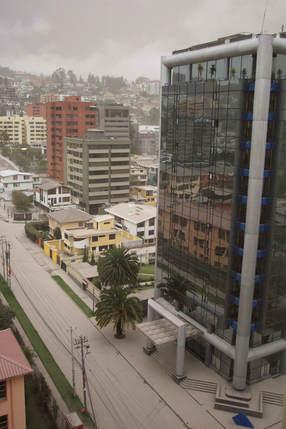 Volcanic covering the streets
Volcanic covering the streets
We arrived in Quito and went to sleep ready to see the sites the next day. Little did we know that the El Reventador Volcano had just erupted 60 miles away. We awoke to find that a state of emergency had been declared, and Quito was covered in two inches of volcanic ash. Fortunately, there were no reports of casualties.
My mother was still determined to see some of the city. An Ecuadorian and his wife offered to drive us around. We wore facemasks. Everywhere was covered in fine, gray ash. It was very quiet. Nothing was open and there were no cars on the road. In the evening, it rained black raindrops on us.
The Quito airport (the only international airport in the country) was closed for weeks. We were bused to an airport a few hours away outside of the volcanic zone to get the plane to Galapagos. On the way home, we left via the small Guayaquil Airport. The line to check in went out onto the street. We were lucky to get on a plane and return to the US.
- If an evacuation is in place, then listen to authorities
- Stay inside and close all windows and doors. Volcanic ash is very unhealthy to breathe.
- If you are outside, get to high ground as lava flows or mud flows travel down. Crouch down and protect yourself for any potential pyroclastics, which are red hot rocks and debris. Cover your head with anything you can find and it nothing, use your arms.
- Protect your lungs from the ash - breathe through a facemask or thin piece of cloth. Protect your eyes with goggles if possible.
- Cover your skin with long trousers and long shirt.
- Expect airports to be closed for a while, airplanes cannot fly in volcanic ash.
- For more tips – How to survive a volcanic eruption
By Helena of Through An Aussies Eyes
The smell of bushfires swept across Canberra, Australia in January 2003. You could also see the smoky haze creeping over the sky and you knew the fire was coming.
Every summer Australia falls victim to multiple bushfires across the country. Bushfire safety is something that is drummed into the Australian public as so many of us live next to the beautiful Aussie bushland. I live in the inner suburbs of Canberra so we never thought the fire would reach us. We listened to the radio and watched TV in anticipation of updates. Luckily we had followed the suggested bushfire survival tips so were prepared, and they helped us survive.
Four people died, over 490 were injured and 470 homes were destroyed or severely damaged due to this bushfire.
Tips on how to survive a bushfire
- Write and regularly practice your bushfire survival plan.
- Have an understanding on how bushfires behave – fires are influenced by vegetation, topography and climate
- Recognise days of high fire danger
- Prepare your home and property – even if you plan to leave early, make sure you remove leaves from your gutter and water down your property.
- Acting on days of high fire – make sure you start preparing your plan on high fire danger days.
- Consider your physical and emotional preparation – be aware of what you can and can’t do.
- For more tips - How to survive a bushfire
By Lori from Fitz 5 On The Go
I have found myself in some uncomfortable situations when it comes to lightning. The worst was being trapped on very small sailboat when the lightening was so bad that when we touched the motor we got shocked. Thankfully it didn’t burn it just stung, a bit like being hit by strong static electricity, or tapping an electric fence.
Lightning is beautiful but it can be a killer. In some areas of the world (like India) lightning is the main cause of death by natural disasters. Luckily, injuries from lightning are usually easily avoidable.
Tips to avoid lighting
- Stay indoors. Avoid bathing, washing your hand and indoor pools. Also avoid land line phones and consider unplugging expensive devices like TV's and computers.
- If you are outdoors, get inside a building or car. Use the 30/30 rule: After seeing lightning, if you can't count to 30 before hearing thunder, get inside. Don't go outside until 30 minutes after the last clap of thunder.
- If you’re in an open area, seek shelter in a low area under a dense growth of small trees but don’t stand too close. Spread out from other people to avoid transferring the shock.
- Crouch as low to the ground as you can only on the balls of your feet, and touch your heels together, you want to minimise the contact you have with the ground. Don’t lie down.
- Avoid tall, isolated objects like tall trees or flagpoles. Lightning tends to strike the tallest object.
- Avoid water completely as it’s a conductor of electricity. If you are in the water – get out. Also avoid metal and wires.
By Dani of Live in 10 Countries
I rented a car a couple of summer's ago, with the aim of driving all the way around Iceland's ring road. It was completely amazing and we got to see literally everything we wanted to - but there was one pretty big disaster.
When we rented the car they warned about sandstorms and we paid the premium for sandstorm specific protection. We were already shelling out for plenty of other things, and the staff at the rental place mentioned that sand can literally strip the paint off your car in minutes. Yikes! Iceland is 25% desert and 80% of sandstorms occur in the south or south east, mainly during Spring or Autumn/Fall.
Of course, as you'd expect with Murphy's law, it had to happen to us. We were in Skeiðarársandur in the South East, and the wind whipped up, turned everything a greyish yellow and the roar of sandy gravel hitting the car was insane. We read afterwards that the winds reached up to 35 mph at the time, and it was completely exposed. My friend and managed to find a sheltered spot to hide in, but the damage was already done.
So how could you handle it better than I did? - Tips on surviving a sandstorm
- If you are in Iceland, check safetravel.is every day. Listen to radio stations in a language you understand (if you can) for alerts. In Iceland 'sandur' means desert so avoid these places.
- If you are in a car, drive slower and seek shelter like a house or a wall as soon as you see one. Honk your horn as you drive as your visibility may be little to none. If you can’t see cars, they can’t see you.
- If you are outside, cover your nose and mouth with either a facemask, bandana or any material you can find. Wrap a piece of cloth around your head to protect your eyes and ears, shield your eyes with your arm.
- Seek shelter, even if you use a rock or wall, or get to high ground (but only if the storm isn’t accompanied by lightning).
- Wait it out. Don’t try and travel in the storm, let it pass before you move.
- For more tips - How to survive a sandstorm
By Margherita of The Crowded Planet
In 2010, we spent four months travelling around India and we fell head over heels for Ladakh, a high-altitude region in the far north of the country, not far from the Pakistani and Chinese border.
Ladakh is one of the few parts of the world where Tibetan culture still survives and has the peculiarity of being a high altitude desert, where it doesn't rain for years. I remember going to a lecture and hearing that sometimes children under 10 years old have never experienced rain.
On the night of August 6th, around midnight, a huge storm broke out in Leh, the capital of Ladakh - I remember being woken up by loud thunderclaps and seeing dozens of lightning strikes at once. It was truly the strongest and most powerful storm we ever saw. The rain eroded the fragile, dry soil, causing a mudslide that killed hundreds of people.
Our hotel was not affected by the mudslide, but we were evacuated anyway, and spent the night on a rooftop, as it kept raining for ages and everyone was afraid another mudslide was about to come.
The mudslide also destroyed both roads connecting Leh, to the rest of India - the region was virtually cut off for months. It was a terrible experience to see a place I loved so much being hit by such a disaster. We spent a week in Leh following the mudslide, and we helped local people dig up and clean their houses, until we were finally airlifted out.
Tips on surviving a mudslide
- Stay away from rivers, creeks and other courses of water
- Go upstairs, try to get to the top of a tall building, or climb onto the roof
- If you are outside, run sideways (at a right angle) away from the mudslide
- For more tips - How to survive a mudslide
I sincerely hope you have learnt something from this post, even if it's which weather apps to download and what you should keep in an emergency survival kit. I know I have.
Trauma following a natural disaster
The good news is that after a natural disaster, most people recover quite quickly.
- Back in the “normal” world, it may feel strange that people around you are carrying on with their lives. You feel like yelling “don’t you realise I’ve just been in a hurricane/earthquake/flood/fire”??
- You may want to only be around people who have experienced the same.
- You may wish to be alone to process the mixture of emotions you are feeling.
- You may want to put it behind you and you move on. No point on dwelling on what happened, it’s done now and you it’s not helping you to relive it by talking about it all the time.
- It’s natural to feel/have felt no emotions, survival mode kicked in and there was too much to process.
- People often feel guilty for various reasons, this is also natural.
- For others, you may find yourself becoming oddly emotional at different times, possibly months in the future.
- Be gentle on yourself, do whatever you enjoy to help your trauma. Yoga, music, art etc.
- Trauma physiologically changes your brain – Your diet is important in combatting this effect. Vitamin D (expose skin to sun) and Magnesium supplements, foods with high levels of magnesium in them will help (avocados, bananas, spinach, kale etc) . Avoid Trans-fats and aspartame (artificial sweetener, diet drinks, packaged foods etc) as they contain amino acid – this is crucial to avoid if you have been through trauma. The brain needs to be healed.
and refer to it before you travel to a new destination
The #FeetDoTravel blog link-up!
We are proud to host the #FeetDoTravel blog Linkup. If you have a blog post you would like to share, feel free to click on the picture below which will take you through to our Facebook Community and drop your link there. The link-up is open from Friday 12.00am (midnight UK time) and will close Sunday 12.00pm (midnight UK time). We are a fun and loyal group who are more than happy to comment, share and reciprocate! Happy Travelling Feet Fans!

